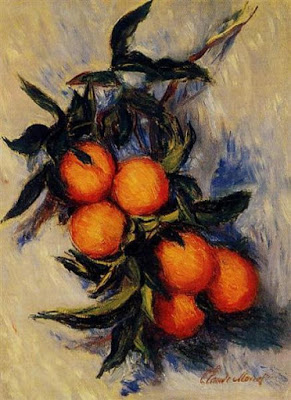by Nina
 |
| Branch of Orange Bearing Fruit by Claude Monet |
Several years ago, I asked Ram Rao to write a series for us on the eight branches of yoga (according to the Yoga Sutras of Patanjali). Although before that time (and since then) we addressed various aspects of the eight branches, such as posts on the individual yamas and niyamas, we did not until then have an overview of the overall structure of eight branches and how they worked together. (The reason I asked Ram to do this was because I knew he came from a family of Vedic scholars in the India.) Fortunately for all of us, he agreed to take it on. Since that series of posts is still as relevant now as it was then, I thought today would be a good time to collect them all into one place. This will not only let you know (if you did not already) that they exist, but will give you easy access to the entire series.
Ram’s first post in the series was Ashtanga Yoga: Following the Eight-Fold Path, which provided an overview of eight branches of yoga defined in the Yoga Sutras and how this eight-fold path fits into the history of yoga. He said:
“The actual term “Ashtanga Yoga” (ashta=eight, anga= limbs) refers to the eight-fold path/eight rungs/limbs/steps of yoga as described in the Raja Yoga section of the yoga philosophy. Its practice helps us to discriminate between ignorance and awareness and truth from illusion, which is the means for liberation or enlightenment.
The underlying principle of the yoga philosophy is the fostering of the wellbeing of an individual at the level of body and mind, and helping an individual re-connect to his/her true nature through direct and personal experience (pratyeksha in Sanskrit). Thus, yoga prepares the body and mind of the individual for eventual liberation and enlightenment.”
In The First Branch of Yoga: Yamas Ram provided an overview of this branch of yoga along with details about the individual yamas. Ram said:
“The practice of yamas lays the foundation from which to develop all the other subtle practices. Yamas serve as moral, ethical and societal guidelines to lead a conscious, honest, and ethical life. There are five yamas or positive guidelines that help us to behave and relate to our surroundings and environment, and to achieve oneness with it. Patanjali considered the five yamas as universal vows and preached that in order to have a harmonious life they be practiced on all levels: by way of thoughts, actions, and words.”
In The Second Branch of Yoga: Niyamas Ram provided an overview of this branch of yoga along with details about the individual niyamas. Ram said:
“Niyamas help us to perform those activities that not only empower us but the society around us as well. Such beneficial activities do not disturb the Self’s natural balance and the environment around us. Performing these activities assists us in gradually recognizing our true nature. The body is at ease; the mind attains peace.”
In The Third Branch of Yoga: Asana Ram provided an overview of how this branch of yoga, asana, works with the other seven branches. Ram said:
“The idea behind the asana practice is to help the mind to become clear or pure and develop deeper mind-body awareness. A clear mind is not affected by stress and a clear mind produces a healthy body thus creating a greater connection with one’s own pure, essential nature. And any individual can achieve mind-body awareness and ultimately attain enlightenment.”
In The Fourth Branch of Yoga: Pranayama Ram discussed what pranayama is and why it is an important part of the eight-fold path. Ram said:
“Pranayama, a formal practice of regulating the breath, consists of techniques designed to gain mastery over the respiratory process while building a connection between the breath, the mind, and the intellect. The technique refers to a particular system of breath control involving three processes namely: puraka (inhalation), kumbhaka (retention), and rechaka (exhalation). When these three processes are balanced, there is union of the body and mind.”
In The Fifth Branch of Yoga: Pratyahara, Ram discusses both the traditional role of pratyahara and his way of bringing branch of yoga into our everyday lives. He said:
“So, to me, the definition of pratyahara is more than just “withdrawal of senses.” In this present world, working at a job, staying with a family, raising kids, etc., all require the coordinated use of the five senses. One cannot withdraw the senses from our daily life’s duties unless we give up on everything and retire to the mountains. So, I like to define pratyahara as “using our senses with total/complete awareness.” In my opinion, practicing pratyahara does not mean running away from a situation or suppressing the impression. Rather, it means being present in the middle of it, being aware of what it is and consciously not reacting but instead choosing how to respond.”
Ram concluded his series with a post Samyama: The Trinity of Dharana, Dhyana, and Samadhi, which addressed the sixth, seventh, and eighth branches of yoga as the three phases of meditation, each of which leads to the next. Ram said:
“the ultimate objective of yoga is reigning in the fluctuations of the mind to achieve complete liberation from mental turbulence—seeing things as they truly are and experiencing only peace. This would be the state of samyama, the ultimate step—peace or enlightenment—which can only be experienced individually.”
I hope you will take some time to check out or revisit some of these posts!
Follow Yoga for Healthy Aging on Facebook ° To order Yoga for Healthy Aging: A Guide to Lifelong Well-Being, go to Amazon, Shambhala, Indie Bound or your local bookstore.


Beautiful and simple distillation.